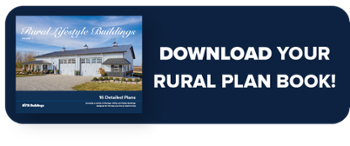Project Prep | Building Tips | Residential Buildings | Horse Barns | Commercial Buildings | Cost | Site Preparation
How to Run Utilities When Building a Pole Barn
Nettie joined the FBi Marketing team in 2022 as the Marketing Content Creator. Nettie grew up just outside of Des Moines, IA. In 2016, she received her BS in Agriculture Communications from Iowa State University. Upon graduation, she has worked in agriculture sales and marketing. She moved to Indiana in 2020. Outside of work, Nettie enjoys quilting, crocheting, crafting, canning, gardening, fishing, and hunting. She is married and enjoys spending time with her husband and dog.
A pole barn can provide extra storage space, a workshop area, or even a residential space if you so desire. You are probably inspired to build after looking at our post-frame building gallery, from barndominiums to commercial pole barns. But does your site have the necessary utilities to get started? It is important to research and make a plan to help eliminate future change orders.
Your lot may need septic, gas, HVAC, electric, and plumbing. A great thing about pole barns is that they are energy efficient. The utilities for pole buildings are subcontracted out for most post-frame builders but are essential for most pole buildings unless you are just storing equipment with no lights.
This blog will cover how to plan for utilities and things to consider. This includes running electrical wiring, installing plumbing, setting up heating and cooling, incorporating internet communication, and safety measures.
How to Plan Utilities For Your Pole Barn
Whether you are buying a lot in town or out in the middle of nowhere, it is important to assess the following factors to get started.
- What utilities, if any, are currently on-site?
- What codes and requirements does your county have?
- What is your budget for utilities?
- What is the size of your pole barn?
- What are your usage requirements?
From there, you can develop a plan. Each project is unique, so we will try to help guide you in the right direction. Our Project Sales Consultants, who are assigned to each quote, can help guide you with past projects they have done in your area.
Another important factor to plan is where your utilities are going to go. A utility box is not an attractive feature, but think through where on the exterior of your pole building you want it to go. In addition, where in the building do you want a utility room? How far away from existing connections will wiring, plumbing, and septic have to run?
Once you have a rough idea of what utilities you need and where you want them to go, you need to ensure your site is prepared for a building to be erected.
Running Electrical Wiring
I have been blessed to grow up with a dad who is a licensed electrician. But not everyone has a family member or friend who is an electrician. It is highly advised to hire a professional when it comes to electrical work. While you may want to save money by running your own electrical, some local codes require a professional.
First, you need to figure out how to get electricity to your building. Is there another building on your property you can run electricity from? Will you need to connect to a cable at the end of your driveway?
The cost of electricity can vary depending on how far away you need to run power and how many outlets and light fixtures you have. Depending on the size and scope of your project, you can pay a couple thousand to $40,000+ for electricity.
Next, you need to pick the location of your electrical panel. Think about where you would like to access it. Would the shop, basement, laundry, or utility room work best for you? It might be cheaper to put it in the corner of the garage near the driveway to save on the distance to run the initial power lines.
When it comes to electrical panel boxes, you can choose between 100-amp and 200-amp service. 100-amp is typically found in older and smaller homes and has fewer circuits. For a pole barn home or pole building with higher usage requirements, you will want 200-amp service.
Plus, a 200 amp breaker box is sometimes required by code and will accommodate future add-ons, providing enough power for a subpanel for extra power in your garage or workshop space.
Think about whether you will want a generator backup for storms. You should also ensure your electrical panel is set up to accommodate your power needs.
Depending on your construction method, wiring a post-frame building vs. a stick-built home is different due to the wall cavity size. In a house, electrical wires are usually run through the hollow space between wooden studs in walls, typically attached to the studs with nails. The wires generally run horizontally, about an inch into the wall and 16 to 18 inches above the floor, in line with outlets.
The advantage of post-frame construction is that it is flexible. Depending on your local code, you can run wiring along the top of the girts. This eliminates having to drill through studs like in traditional stick-built construction. This not only saves time and money in labor but also has no structural impact.
In post-frame, the columns are spaced 8’ on center, so you will need to think through where you want your outlets, how many, and where they will fall in the floor plan. Typically you would run wiring to an outlet every 4’- 8’.
Next, think about your ceiling. Are you going to have a metal ceiling liner package, cover the trusses with tongue-and-groove boards, or use sheet rock, or do you want an open concept with exposed trusses?

Then, consider how many light fixtures are in each room. Do you want recessed lighting, ceiling fans, etc.?
Electricians will need to run the wiring and housing for light fixtures before the ceiling is installed.
Adding solar panels can be a cost-effective option. Plus, they can increase your property's value. In addition, there are sometimes tax incentives for adding solar panels. Solar panels tie into your breaker box.
Installing Plumbing
Creating your plumbing plan ahead of time will save you a lot of time and money. Think through all the places you need water, and don’t forget if you want a sink in the shop! Otherwise, you may have to cut through your concrete to install additional plumbing in the future.
The closer your bathroom(s), kitchen, laundry, and water source needs are, the less plumbing you will need to run. One way to achieve this is to find a floor plan where these rooms are in line with each other or are closer to one another.
When it comes to plumbing, it is also important to factor in whether you are going to stub in plumbing ahead of your concrete. Will you have a second floor and run the plumbing through your interior walls? Will you want a sink on an exterior wall? Is there enough insulation, and do you have a vapor barrier there to protect from freezing?
Plus, consider your septic system. Are you tying into an existing system, or do you need to install a new system? An important consideration when it comes to septic is the slope of the pipe. This will impact your overall site plan elevation and any additional site prep work that might need to be done. If your septic is too steep, the liquid will outrun the solids. If it is not sloped enough, it will not drain properly. Typically, the sewer code is ⅛-¼” drop per foot.
In plumbing, SCH 40 pipe is typically used to connect main lines, with PEX used for water lines and hot water heaters. Think through where your main lines will connect and look into local codes.
Heating and Cooling
While pole barns are known for being energy efficient, depending on the insulation you choose can have a big impact on the transfer of air from the outside inside.
Spray Foam is a popular choice but can be costly. Once you have chosen how to insulate and finish the inside walls, you will need to consider how to regulate the pole building's temperature.
There are three common ways to heat pole barns. Some may require you to run a gas line or have a propane tank on your site. Think through the following heating and cooling options.
Once you select how you want to control your pole barn’s temperature, look at where your heat source is located. Remember to check your local code for rules and regulations regarding gas lines.
1) Furnace
Furnaces create heat by burning fuel, usually natural gas or propane. Commonly used in homes, furnaces can also be used in pole barns and in fully finished interiors.
But remember, if you decide to put a furnace in your pole barn, it will require a forced air distribution system involving ductwork.
 2) Heat Pump
2) Heat Pump
Heat pumps are extremely efficient to operate, but you should be aware that compared to conventional systems, they:
- Have a higher initial cost
- It takes much longer to warm up or cool down a space
- Require movement of a higher volume of air
3) Radiant Floor Heat
Speaking of plumbing, a popular option many of our customers choose is radiant heat. This consists of a water heater hooked up to PEX tubing running underneath your subfloor or concrete slab. The hot water warms the water that runs through the tubes, and the concrete acts as a thermal mass to retain heat.
Depending on the size and scope of your project, you can pay anywhere from $7,000- $25,000+. While this is a large upfront cost, long-term savings can be significant.
Some of the benefits of radiant floor heating include:
- more efficient than forced-air heating
- eliminates duct losses
- It doesn't distribute allergens like forced air systems can
Cooling
Next, you need to consider how you are going to keep your building cool in the heat of summer. Sometimes opening windows, doors, and installing a big ass fan is not enough. You may need to consider a wall or window AC unit.
If you decide you want to cool all or a large portion of your building, you should consider installing a central air conditioning system or – for greater efficiency – a heat pump.
Hiring an HVAC technician is vital to ensure you get the proper size unit. If you get too big of an air conditioning unit, it may not run enough to reduce the humidity, resulting in potential mold problems. If you get too small of a unit, it also will not cool efficiently.
Incorporating Internet and Communication
Pole barns are popular choices for commercial and agribusiness. However, some debate whether the all-metal exterior affects cell phone signal.
You will need to consider where your post-frame structure is located and what communication needs you will have. Is there local fiber or cable internet? Are you going to rely on a local cell phone provider for internet capabilities? How many bars does your cell phone get on your lot? Will Starlink Internet be a good fit for your communication needs?
This is a factor not always considered, but it can be vital if you work remotely and rely on a good internet connection. If you think the metal will impact your connection, you can consider a shingled roof or alternative pole barn siding materials.
Safety Measures and Inspections
Safety always needs to come first. While you might want to save money by doing it yourself, some things are best left to the professionals. Plus, building codes may require a professional.
A common misconception is that people think since they are building a barn, they can do whatever they want. This is simply not true. While post-frame construction does allow you to have more design flexibility, and clear span trusses are not load-bearing, there are still local codes and engineering parameters that must be followed, especially when it comes to building a post-frame home or commercial facility.
Fire safety is an important element. Fire block walls are required in some commercial buildings. Also, consider smoke alarms and where they may be required in your facility. Does the code require a sprinkler system?
Do You Have a Plan for Your Pole Barn Utilities?
Having a well-thought-out plan for your pole barn utilities is essential to ensure that your building is not only functional but also safe. Professionals should do electrical wiring to avoid any potential hazards. Plumbing layout and heating options need to be carefully considered to ensure efficiency and convenience.
Additionally, incorporating internet and communication systems will allow you to stay connected and productive in your pole barn. Safety measures and inspections should not be overlooked, as they are crucial for the well-being of everyone using the building. By taking the time to plan and install utilities properly, you can create a space that meets your needs and is built to last.
Ready to get started? Give us a call at (800) 552-2981 or click the button below for a free pole barn estimate.
Have more questions about pole barn trusses not covered in this article? Please contact FBi Buildings at 1.800.552.2981 or click here to email us. If you are ready to get a price, click here to request a quote and a member of our sales team will call you.





